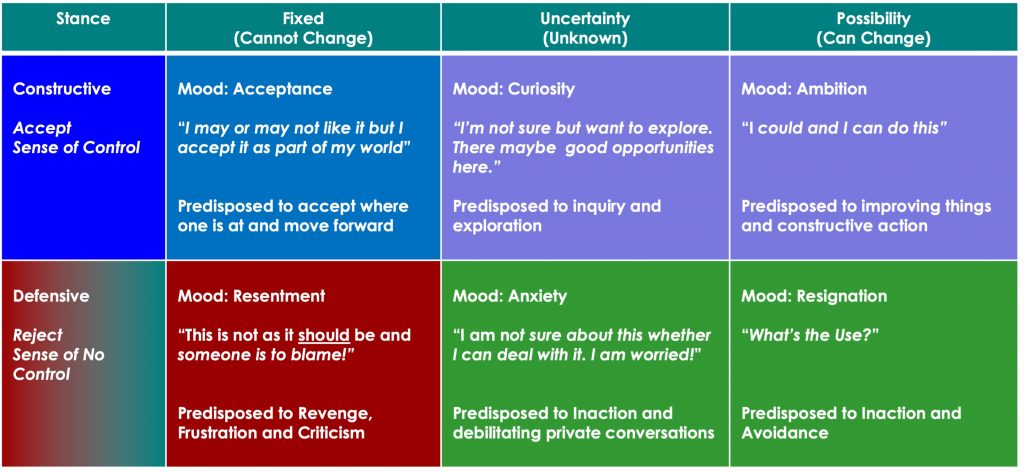
Our moods are feedback loops of habitual ways of making predictions and simulations based on our habitual ways of observing. Those simulations impact our body resources leading to certain interoceptive sensations showing up as habitual patterns of affect. We call these patterns our moods, some of which are so common, we refer to them as ‘basic moods’.
To define these basic moods, we put our habitual patterns of affect into the context of two basic stances we take to the world (constructive and defensive), our core concerns and the future and what we believe we can influence and change.
Remember, a constructive stance involves being able to accept the world as we perceive it and then seeking to construct a way forward from there. A defensive stance assumes the world is not one we want now or into the future, and we must protect ourselves from it and protect what we have. Simply put, in a constructive stance we tend to accept the world and engage with possibilities for enhancement and in a defensive stance, we tend to reject those things seeking to retain the status quo.
As Heraclitus said, “No man ever steps in the same river twice”, indicating we live in a world of constant change. However, not everything can change, and we have stories about what we can change, and what we cannot.
It is critical to recognise what we believe to be unchangeable or changeable is an interpretation we make about ourselves and the world. Those assessments relate to how we uniquely observe the world and may or may not reflect what is so. However, it is easy to be seduced into living our interpretations as the truth. Take an example that I have often heard people say, “I am who I am, and I cannot change that“. By holding this story, those individuals live their life as if this is the truth about themselves rather than their assessment of their capacity to change. In doing so, they limit their capacity to learn and adapt. They see their current ways of being as the reality without much possibility, if any, of change.
Based on these keys ideas – stance and what we see as fixed or possible – we can now define some basic moods in life that fall largely into two categories – defensive moods and constructive moods.

Defensive Moods
When we take a defensive stance to the world, our predictions focus on the world as a threat and the need to protect ourselves from that threat. We do not seek to add to what we have but rather we seek to maintain what we already have.
These sorts of predictions seek outcomes that will deal with situations we do not want in life such that we will either deal with them directly or move away from them. When we see the world from a defensive stance, we find ourselves on alert and often see threat where none exists.
A defensive stance can take two broad forms – aggressive or passive. In an aggressive stance our predictions focus on directly or indirectly intervening in some way. In a passive stance, our predictions focus on how to remove ourselves from situations.
The Mood of Resentment
- Defensive stance to what we believe is unchangeable
- Unpleasant sensations with low to medium arousal
- Sense of no control
- Indicators include frustration and cynicism
- Predisposition for retribution and revenge
When we habitually have a defensive stance to what we believe to be unchangeable, we can find ourselves in an unpleasant emotional space. We would like what we see as unchangeable to be changeable. This stance leads to assessments that we have little or no control or influence over our world and we often look for someone or something to blame for the unsavoury situations in which we find ourselves.
The mood associated with these related patterns of prediction is the mood of resentment.
Resentment provides feedback about patterns of prediction creating simulations that often do not match our sensory perception. The world is not how we want it to be. Rather than shifting our predictions to account for the feedback, we continue to utilise our habitual predictions and speak of how the world should be rather than how our senses tell us it is. This can lead us to general assessments that the world is unfair and often we need to blame others to protect our self-story.
Resentment also speaks to an inequitable balance of authority leading to a lack of control and blame. Accordingly, with resentment there is a predisposition for retribution ranging from passive action such as avoiding cooperation through to direct aggressive action.
The Mood of Anxiety
- Defensive stance in the context of how we will deal with uncertainty
- Unpleasant sensations with low to medium arousal
- Sense of self-doubt or incompetence
- Indicators include tentativeness, agitation, and confusion
- Predisposition to flight, tentative action or inaction
A mood of anxiety generally involves a story that we will not be able to deal with an unknown future and the outcome will not be good for us. It tends to relate to doubting ourselves and our ability producing an assessment that the world is a threatening place.
In a mood of anxiety, our habitual predictions create simulations often not matching our perceptions such that we doubt our capacity to deal with various situations in life. As such, we find ourselves in a constant state of breakdown not trusting how we observe or act.
Anxiety generally involves low to medium arousal and varying degrees of unpleasantness.
The Mood of Resignation
- Passive defensive stance to possibility
- Unpleasant sensations with low arousal
- Sense of no hope
- Indicators include apathy and avoidance
- Predisposition to avoidance and inaction
When we generally take a defensive stance in the context of possibility, we also declare that, even though we do not accept how things are, there is no hope of any change and there is no space of possibility. How we are now, will be how we will be in the future. How the world is now, is how it will be in the future.
The mood associated with these patterns of prediction is a mood of resignation.
A mood of resignation generally stems from predictions that our action will make no difference so there is little or no point in doing anything. This is a passive response to the world with avoidance and little or no action as a primary means of dealing with it.
In a mood of resignation, our habitual predictions have created simulations that establish our way of interpreting what is possible. We will tend to observe the world as one where we can make no difference meaning our simulations are confirmed. However, every now and then we find ourselves offered possibilities by others that create a breakdown we cannot ignore. In resignation, we might push back on the possibility or seek to avoid it all together.
Resignation generally involves low arousal and varying degrees of unpleasantness.
A mood of resignation across all aspects of our life can show up as depression.
Constructive Moods
When we take a constructive stance to the world, our predictions focus accepting the world as observe and seeking to construct a future that will better serve us.
When we see the world from a constructive stance, we find ourselves seeking to engage with it in a positive way.
The Mood of Acceptance
- Constructive stance to what we believe is unchangeable
- Mild unpleasant, neutral or pleasant sensations with low arousal
- Sense that things have changed and that is the way things are
- Predisposition to accept what cannot be changed and to move on
If our habitual predictions create simulations that are generally consistent with our perceptions of the world and we accept it as such, regardless of whether we like it or not, we can be said to be in a mood of acceptance. As a result, we trust our observations and then move onto predictions about how to enhance our situation.
When we generally accept what we assess cannot be changed, we declare an acceptance of ourselves as we are and the world as it is. It is important to note that acceptance of something does not necessary mean liking it. We may not like the world as we perceive it but appreciate that we must deal with it.
A mood of acceptance involves a story that we can move on from what is and create something from it. What we assess is unchangeable is seen as a context for the future and not an unacceptable constraint.
Acceptance involves low to medium arousal and either low degrees of unpleasantness or varying degrees of pleasantness depending on how we assess our general circumstances.
The Mood of Curiosity
- Constructive stance to self in uncertainty
- Neutral or pleasant sensations with low to medium arousal
- Sense of openness and wonder
- Indicators include enthusiasm and openness to experiences
- Predisposition to explore our breakdowns and learning
In a mood of curiosity our patterns of prediction welcome breakdowns as an opportunity to explore what could be created and add to our world. We may not yet see possibilities, but we seek them.
When we accept our capacity to deal with uncertainty, we declare that we are willing to explore the unknown. Such a stance means that we might find something new in the world or about ourselves. It also implies we see ourselves as capable of dealing with what may come our way.
Curiosity involves low to medium arousal and varying degrees of pleasantness depending on how we feel about our general circumstances.
The Mood of Ambition
- Constructive stance to possibility
- Pleasant sensations with low to medium arousal
- Sense of optimism and opportunity
- Indicators include focused energy and engagement
- Predisposition to learning and creation
When our patterns of prediction expect breakdowns that we assess provide a chance to create something, we can find ourselves in a mood of ambition.
When we accept possibility or seek to create it, we declare that things can be different. Such a stance means we can construct something new in the world or become someone better.
Ambition involves low to medium arousal and varying degrees of pleasantness depending on how we feel about our general circumstances. The feedback can be interpreted as a readiness to step into constructive action